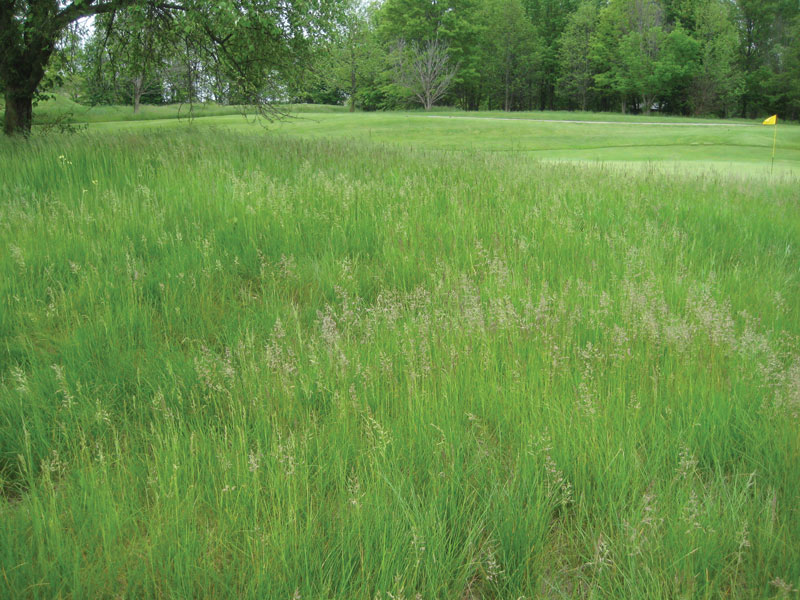
Figure 1. A minimal-mow fine fescue natural rough area at Kampen Golf Course in West Lafayette, Ind. Photo by Ross Braun
Editor’s note: This article is the fourth and final in a series about fine fescues on golf courses. Read the previous three installments: Classifying fine fescues used on golf courses, Fine fescues on golf courses: Availability, establishment, management, and Fine fescues on golf courses: Abiotic stresses.
Five fine fescue grasses are commonly used in turfgrass systems: strong creeping red fescue (Festuca rubra subspecies rubra), slender creeping red fescue (Festuca rubra subspecies littoralis), Chewings fescue (Festuca rubra subspecies commutata), sheep fescue (Festuca ovina) and hard fescue (Festuca brevipila) (Table 1).
Interest in fine fescue use is growing because of their low-input (nitrogen fertilizer, irrigation and pesticide) requirements, slow-growth characteristics, and versatility under different management conditions and mowing heights (Figure 1, above). These grasses are being intensively studied by a team of researchers working on a grant titled “Increasing Low-Input Turfgrass Adoption through Breeding, Innovation, and Public Education” from USDA-NIFA through the Specialty Crop Research Initiative.
These five fine fescues struggle with some of the same common biotic — weed, disease and insect — pests as other cool-season turfgrass species (5). In this final article of our four-part series, we will discuss the more common and problematic biotic pests and differences in tolerance to those pests among fine fescue taxa.
Weeds in fine fescues
Grassy and broadleaf weed invasion is a continuous challenge in all managed areas on a golf course, as these weeds disrupt the aesthetic appearance and/or playability of the turf, and they also compete for light, water and nutrients. Fine fescues in managed areas encounter many of the same common grassy and broadleaf weed pests as other turfgrass species. However, under various management situations, fine fescues have shown similar or greater resistance to weed invasion than other turfgrass species, especially in the absence of or with minimal use of irrigation, fertilizer and herbicide inputs (5).
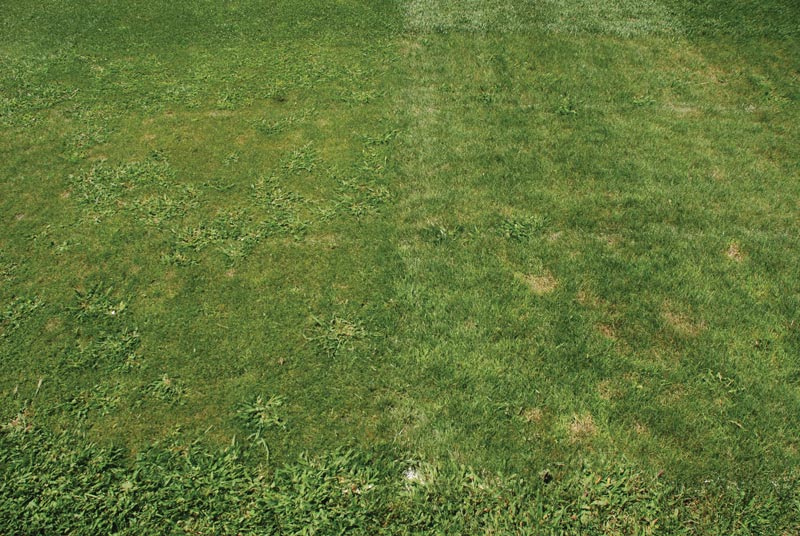
Figure 2. An increase in mowing height (right) enhances turf quality and reduces crabgrass invasion in Chewings fescue plots in mid-August in West Lafayette, Ind. Photo by Aaron Patton
Increasing mowing height has been shown to reduce grassy and broadleaf weed invasion in fine fescues by 35% to 95%, whereas increasing nitrogen application rates is a less effective strategy (5) (Figure 2, above). Overall, when cultural management strategies are inadequate for weed control, many pre- and post-emergence herbicide options are available to control broadleaf and grassy weeds in fine fescue turf (5).
Annual bluegrass (Poa annua) is the most problematic weed species in both creeping bentgrass (Agrostis stolonifera) and fine fescue putting greens (2), but specific cultural management practices may help prevent the encroachment of annual bluegrass in fine fescue greens. These practices include: using a composition of multiple fine fescues, especially slender creeping red fescue; using high-density cultivars; using mixtures of fine fescues with bentgrasses (Agrostis species); raising the mowing height by at least 0.06 inch (1.5 millimeters); optimizing spring nitrogen fertilization timing; and implementing deficit irrigation programs (5).
Unfortunately, few pre- and post-emergence herbicide or plant growth regulator options effectively prevent or control annual bluegrass without injuring the desirable fine fescue turf (5). PoaCure (methiozolin, Moghu USA), which was recently registered in the U.S., has been shown to be a possible solution for post-emergence annual bluegrass control in stands of strong creeping red fescue or Chewings fescue, although caution should be taken in using PoaCure on hard fescue (12).
Editor’s note: Get much more information on PoaCure, including research findings and registration information, in PoaCure: Has annual bluegrass finally met its match?
The fine fescue taxa have also shown tolerance to varying rates of glyphosate, which could provide an effective option for control of broadleaf and grassy weeds — including annual bluegrass — in low maintenance golf course areas or potentially more intensively managed fine fescue areas (1) (see Table 1, Recommended taxonomic classification, characteristics and rankings of the five fine fescue taxa).
Recently, researchers at Virginia Tech reported that all five fine fescue taxa are inherently tolerant of glyphosate at rates below 0.62 pound/acre (0.7 kilogram/hectare), with hard fescue being the most tolerant, followed by sheep fescue, strong creeping red fescue, slender creeping red fescue and Chewings fescue (Table 1) (1). Other researchers (8, 10) had previously reported similar glyphosate tolerance in fine fescues, specifically hard fescue. Applying glyphosate at low rates is one of many weed control options in fine fescues, and care should be taken when using glyphosate, as herbicide resistance may develop over time. Additional research is required on this topic to investigate turf safety under different environmental and golf course management conditions.
Results from field studies across various locations indicate noticeably different weed-suppressive tendencies among fine fescue taxa and cultivars, which could be associated not only with the characteristics of quick establishment and a dense canopy, but also with potential allelopathic traits (5) (Table 1).
Allelopathy — chemical inhibition by surrounding plants — is an important characteristic that some fine fescues use to suppress weed invasion. Plants with allelopathic traits release chemicals that inhibit and suppress root and shoot growth of surrounding plants, such as weeds. This has been documented in cultivars of Chewings, strong creeping red fescue and hard fescue (5).
Editor’s note: University of Minnesota scientists detailed some of their work evaluating allelopathy in fine fescues in the March 2019 GCM article Natural weed suppression in fine fescues.
In addition to suppressing weed invasion, allelopathy could potentially help reduce herbicide requirements. However, all five fine fescue taxa require further testing, especially in field settings (5). Therefore, as part of the USDA-NIFA grant, researchers at the University of Minnesota are currently conducting experiments to screen and analyze for specific allelochemicals found in fine fescues.
Diseases of fine fescues
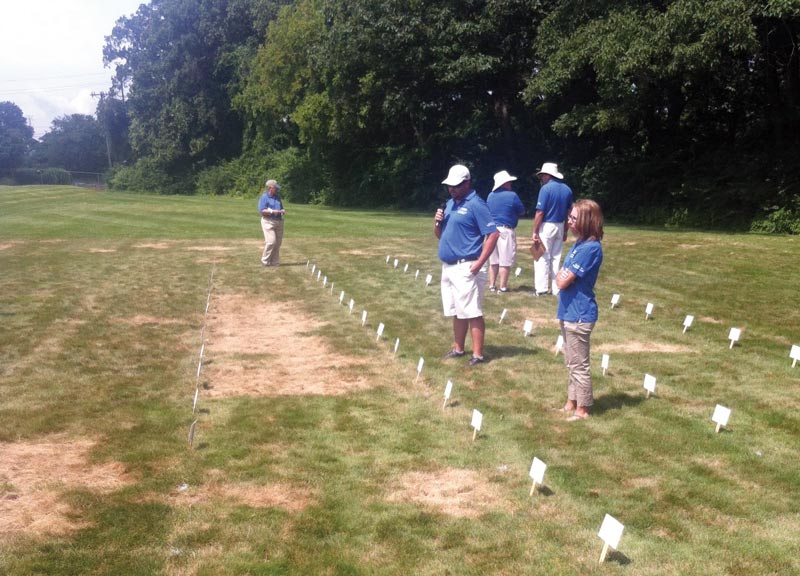
Figure 3. Test plots show differences in summer patch susceptibility among fine fescue taxa and cultivars in North Brunswick, N.J. Photo by Eric Watkins
Some of the most problematic disease pests for fine fescues include summer patch (Magnaporthiopsis poae and M. meyeri-festucae); red thread (Laetisaria fuciformis); dollar spot (Clarireedia subspecies); snow molds: Microdochium patch or pink snow mold (Microdochium nivale), Typhula blight or gray snow mold (Typhula incarnata), and speckled snow mold (T. ishikariensis); and pink patch (Limonomyces roseipellis) (3, 14, 15) (Figures 3, 4, 5).
Though fine fescue disease-resistance data is relatively limited, resistance among the fine fescue taxa varies by disease, with no one fine fescue consistently more resistant than the others to all diseases (5) (Table 1).
Summer patch, a root-infecting disease, is arguably the most destructive disease of fine fescues, and a new pathogen (Magnaporthiopsis meyeri-festucae) that can contribute to summer patch symptoms was recently identified in fine fescues (9, 15) (Figure 3, above). Therefore, as part of the USDA-NIFA grant, researchers at Rutgers and USDA-ARS are conducting field and genetic mapping experiments on summer patch to develop management practice recommendations and identify candidate genes for summer patch resistance for fine fescue breeding populations.
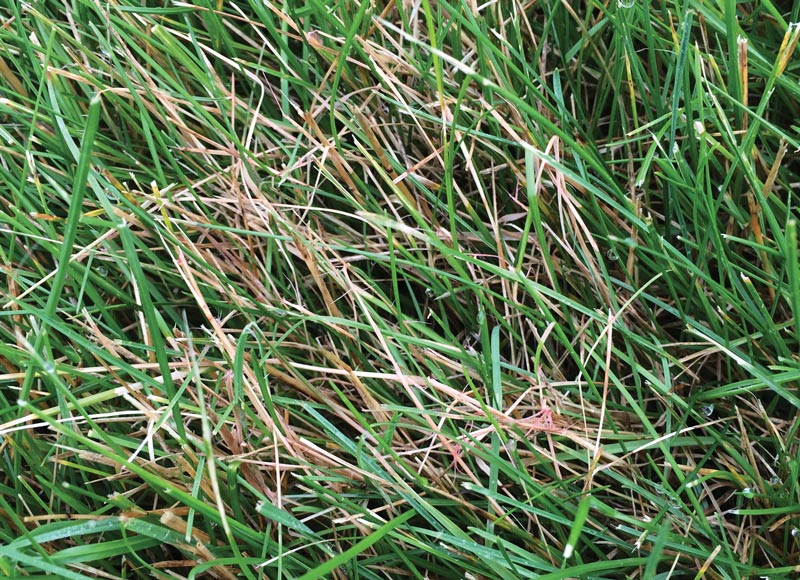
Figure 4. This fine fescue is showing symptoms of red thread, which occurs more often in cultivars of strong creeping red fescue and slender creeping red fescue than in other fine fescue taxa. Photo by Paul Koch
Red thread, pink patch and dollar spot are all common foliar diseases of fine fescue. Many of the recommended cultural management practices — such as increasing nitrogen fertility to reduce disease severity in other turfgrass species — are similar for fine fescues (Figure 4, above). Another potential method for improving red thread and dollar spot resistance in fine fescues is to incorporate fungal endophytes (Epichloë species) (4, 6).
Endophytes are fungi that inhabit the turfgrass leaf blade and provide the plant with defense chemicals called alkaloids that provide numerous protections against biotic and abiotic stressors. Improved disease resistance from endophyte infection may be unique to fine fescues, as it has not been observed in other endophyte-infected turfgrass species such as tall fescue (Festuca arundinacea, synonym Schedonorus arundinaceus, synonym Lolium arundinaceum) or perennial ryegrass (Lolium perenne) (5). This beneficial characteristic may potentially reduce fungicide use in fine fescue compared with other commonly used turfgrass species.
Microdochium patch and Typhula blight — known as snow molds — are destructive diseases of fine fescues in regions that experience prolonged periods (>60 days) of snow cover or extended periods of cool, moist conditions with little to no snow cover (5, 15) (Figure 5, below). Bentgrasses (Agrostis species) are highly susceptible to snow molds, and fungicide applications are often required in temperate climates for acceptable disease control (2). However, researchers in Wisconsin observed that strong creeping red fescue, slender creeping red fescue and Chewings fescue all had greater snow mold resistance relative to bentgrass species at golf course fairway height, suggesting that fewer fungicides may be required to suppress snow mold on fine fescues (7). As part of the USDA-NIFA grant, researchers at Wisconsin, Minnesota and USDA-ARS are conducting experiments to screen and investigate the mechanism of snow mold resistance in fine fescues and identify candidate genes for snow mold resistance for fine fescue breeding programs.
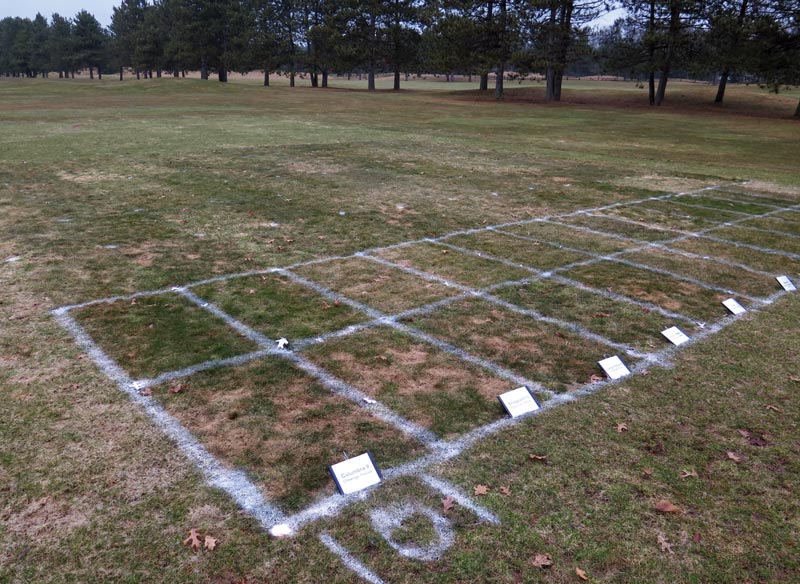
Figure 5. Visible differences in speckled snow mold susceptibility were found among fine fescue cultivars in Minocqua, Wis. Photo by Paul Koch
Fine fescue susceptibility to some problematic turfgrass diseases may be one of the reasons for opposition to incorporating these grasses in different areas of the golf course (5). However, disease susceptibility clearly varies among fine fescue taxa (Table 1). Thus, selection of resistant fine fescue taxa or mixtures of fine fescue taxa based on known disease pressures for a given site will help decrease disease development. Furthermore, future disease screening that includes all five fine fescues will help researchers and golf course superintendents gain a better understanding of resistance differences among the taxa.
Until improved fine fescue cultivars with enhanced resistance and new cultural management strategies that suppress disease are available, fine fescue cannot be widely planted in regions like the Mid-Atlantic and Northeastern U.S., where disease pressure from highly destructive diseases like summer patch is common (5).
Insects and fine fescues
The most common and destructive insect pests of fine fescues include hairy chinch bug (Blissus leucopterus hirtus), bluegrass billbug (Sphenophorus parvulus), greenbug (Schizaphis graminum), sod webworms (various genera in the family Pyralidae) and fall armyworm (Spodoptera frugiperda) (3, 13, 14). Despite the destructive consequences of these insect pests, little research on fine fescues has been conducted (5).
In addition to improving foliar disease resistance mentioned above, endophyte-infected (also known as endophyte-enhanced) fine fescues have improved resistance to surface-feeding insect (hairy chinch bugs, fall armyworm larvae) damage because the alkaloids produced by the endophyte act as a deterrent (5). However, endophytes offer no protection against root-feeding insects such as white grubs, as fungal endophytes do not reside in the roots (11). If golf course superintendents wish to capitalize on the benefits of endophytes in fine fescues, then proper seed storage practices are crucial to maintain endophyte longevity in fine fescue seed (5). Using endophyte-enhanced fine fescues in combination with proper cultural practices should help prevent and suppress insect pests and potentially lessen reliance on routine insecticide applications.
Biotic pests in fine fescue seed production
Fine fescue seed production fields also encounter many different biotic pests that damage the crop and reduce seed yield, and these are often some of the same pests found in managed turfgrass systems. More specifically, some of the primary yield-limiting pests include the grey field slug (Deroceras reticulatum), sod webworm larvae (Chrysoteuchia topiaria) and gray-tailed voles (Microtus canicaudus) (5).
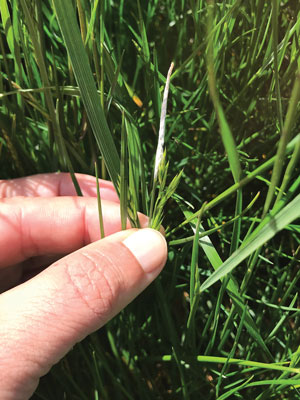
Right: Figure 6. Choke disease is a common biotic stress in Oregon fine fescue seed production and is detrimental because it can prevent the emergence of the seedhead. Photo by Nicole Anderson
Choke disease, which is caused by fungal endophytes (Epichloë species), is another common biotic stress in Oregon fine fescue seed production and is detrimental because it can prevent the emergence of the seedhead (5) (Figure 6). Herbicide-resistant grass weeds are also of considerable concern, especially annual ryegrass (also known as Italian ryegrass) (Lolium multiflorum) and annual bluegrass. Many seed producers and local agronomists believe that pest pressure from these species has increased across the region since open-field burning has become more limited by state regulations, as mentioned in the second article in this series. Common weed seed contaminants in fine fescue seed lots are typically winter annual grassy weeds, such as annual bluegrass and rattail fescue (Vulpia myuros) (5).
Final comments
Like other turfgrass species, fine fescues encounter weed, disease and insect pest problems, but some fine fescues possess allelopathic weed suppression traits, better disease resistance and/or fungal endophytes, which can help superintendents reduce the use of pesticides.
Ongoing research and breeding efforts continue to develop better management practices and release new and improved fine fescue cultivars to help improve resistance to biotic stresses, which may potentially reduce pesticide requirements and enhance sustainability of fine fescue areas on golf courses.
In all four parts of this series, we clearly document the known differences in growth, production, establishment, management, utilization, stress tolerance and pest tolerance among fine fescue taxa. Therefore, moving forward, we encourage you to begin to refer to each fine fescue taxa individually, which will be beneficial not only to you, the golf course superintendent managing these grasses, but also to your clientele and fellow superintendents, who will then be better able to recognize the strengths and weaknesses of each fine fescue taxon. In addition, referring to each fine fescue taxon individually instead of as a single group (“fine fescues”) will help you rationally select and manage either an individual fine fescue taxon or a mixture of fine fescue taxa on your golf course.
Fine fescues in previous issues of GCM
In case you missed it, in part I, we discussed the recommended taxonomic classifications and a brief history of the five fine fescues. In part II, we discussed seed and sod availability challenges, establishment, fertility, and mowing practices of fine fescues. In part III, we discussed tolerance differences of abiotic stresses (drought, submersion, heat, traffic, salinity, shade) among the fine fescues. See our blog, and follow us on Twitter and Facebook.
Funding
This work was funded by the National Institute of Food and Agriculture, U.S. Department of Agriculture, Specialty Crop Research Initiative (2017-51181-27222). The full manuscript is available through open access in Crop Science (https://doi.org/10.1002/csc2.20122).
The research says ...
- Fine fescues struggle with many of the same weeds, diseases and insect pests as other cool-season turfgrass species.
- The most problematic biotic pests for fine fescues include annual bluegrass invasion and diseases such as summer patch, red thread, dollar spot and snow molds.
- Research on the prevention and control of these pests in fine fescues has concentrated on cultural and chemical practices but also on allelopathy and endophytes.
- Some fine fescues and cultivars possess weed-suppression traits and/or fungal endophytes, which can reduce pesticide requirements for low-input sites.
- The differences in resistance to weed invasion and disease susceptibility among fine fescue taxa should influence species selection and management preferences for your site.
Literature cited
- Askew, S.D., W.B. Askew and J.M. Goatley. 2019. Fineleaf fescue species and variety tolerance to glyphosate. Weed Technology 33:185-191 (https://doi.org/10.1017/wet.2018.65).
- Beard, J.B. 2002. Turf management for golf courses. 2nd ed. Ann Arbor Press, Chelsea, Mich.
- Bonos, S.A., and D.R. Huff. 2013. Cool-season grasses: Biology and breeding. Pages 591-660. In: J.C. Stier, B.P. Horgan and S.A. Bonos, editors. Turfgrass: Biology, use, and management. Agronomy Monograph 56. ASA, CSSA, SSSA, Madison, Wis. doi:10.2134/agronmonogr56.c17
- Bonos, S.A., M.M. Wilson, W.A. Meyer and C.R. Funk. 2005. Suppression of red thread in fine fescues through endophyte-mediated resistance. Applied Turfgrass Science 2(1):1-7. doi:10.1094/ATS-2005-0725-01-RS
- Braun, R.C., A.J. Patton, E. Watkins, P. Koch, N.P. Anderson, S.A. Bonos and L.A. Brilman. 2020. Fine fescues: A review of the species, their improvement, production, establishment, and management. Crop Science 60:1142-1187 (https://doi.org/10.1002/csc2.20122).
- Clarke, B.B., J.F. White Jr., R.H. Hurley, M.S. Torres, S. Sun and D.R. Huff. 2006. Endophyte-mediated suppression of dollar spot disease in fine fescues. Plant Disease 90:994-998. doi:10.1094/PD-90-0994
- Gregos, J., M.D. Casler and J.C. Stier. 2011. Resistance of closely mown fine fescue and bentgrass species to snow mold pathogens. Plant Disease 95:847-852. doi:10.1094/pdis-11-10-0791
- Hart, S.E., J.F. Derr, D.W. Lycan, C. Rose-Fricker and W.A. Meyer. 2005. Increased glyphosate tolerance in ‘Aurora Gold’ hard fescue (Festuca longifolia). Weed Technology 19:640-646 (https://doi.org/10.1614/WT-04-200R.1).
- Luo, J., P.L. Vines, A. Grimshaw, L. Hoffman, E. Walsh, S.A. Bonos, B.B. Clarke, J.A. Murphy, W.A. Meyer and N. Zhang. 2017. Magnaporthiopsis meyeri-festucae, sp. nov., associated with a summer patch-like disease of fine fescue turfgrasses. Mycologia 109:5:780-789. doi:10.1080/00275514.2017.1400306
- McCullough, P.E., J. Yu, D.G. Schilling and M.A. Czarnota. 2015. Physiological basis for glyphosate tolerance in hard fescue and perennial ryegrass cultivars. Crop Science 55:2352 2358. doi:10.2135/cropsci2015.01.0035
- Potter, D.A. 1998. Destructive turfgrass insects: Biology, diagnosis, and control. Ann Arbor Press, Chelsea, Mich.
- Qu, Y., R.M. Daddio, P.E. McCullough, S.A. Bonos and W.A. Meyer. 2019. Phytotoxicity of methiozolin on fine fescue. HortTechnology 29(3):265-270. doi:10.21273/HORTTECH04278-19
- Ruemmele, B.A., J.K. Wipff, L. Brilman and K.W. Hignight. 2003. Fine-leaved fescue species. Pages 129-174. In: M.D. Casler and R.R. Duncan, editors. Turfgrass biology, genetics, and breeding. Wiley, New York.
- Ruemmele, B.A., L.A. Brilman and D.R. Huff. 1995. Fine fescue germplasm diversity and vulnerability. Crop Science 35:313-316.
- Smiley, R.W., P.H. Dernoeden and B.B. Clarke. 2005. Compendium of turfgrass diseases. 3rd ed. APS Press, St. Paul, Minn.
Ross C. Braun is a lead research scholar, and Aaron J. Patton is interim department head and a professor in the Department of Horticulture and Landscape Architecture at Purdue University, West Lafayette, Ind. Eric Watkins is a professor in the Department of Horticultural Science at the University of Minnesota, St. Paul, Minn. Paul L. Koch is an associate professor in the Department of Plant Pathology at the University of Wisconsin, Madison, Wis. Nicole P. Anderson is a field crops Extension agent in the Department of Crop and Soil Science at Oregon State University, Corvallis, Ore. Stacy A. Bonos is a professor in the Department of Plant Biology and Pathology at Rutgers University, New Brunswick, N.J. Leah A. Brilman is the director of product management and technical services at DLF Pickseed USA, Halsey, Ore.